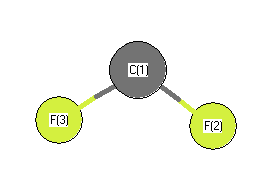Vibrational levels (cm-1) 
| Mode Number |
Symmetry |
Frequency |
Intensity |
Comment |
Description |
| Fundamental(cm-1) |
Harmonic(cm-1) |
Reference |
(km mol-1) |
unc. |
Reference |
| 1 |
A1 |
1225 |
|
webbook |
|
|
|
|
CF2 s-str |
| 2 |
A1 |
667 |
|
webbook |
|
|
|
|
CF2 sciss |
| 3 |
B2 |
1114 |
|
webbook |
|
|
|
|
CF2 a-str |
vibrational zero-point energy: 1503.3 cm
-1 (from fundamental vibrations)
Calculated vibrational frequencies for
CF
2- (Difluoromethylene anion).
Geometric Data

Point Group C2v
Internal coordinates
distances (r) in Å, angles (a) in degrees, dihedrals (d) in degrees
Cartesians
| Atom |
x (Å) |
y (Å) |
z (Å) |
| C1 |
0.0000 |
0.0000 |
0.5932 |
| F2 |
0.0000 |
1.0282 |
-0.1977 |
| F3 |
0.0000 |
-1.0282 |
-0.1977 |
Atom - Atom Distances 
Distances in Å
| |
C1 |
F2 |
F3 |
| C1 |
|
1.2972 | 1.2972 |
| F2 |
1.2972 |
|
2.0563 |
| F3 |
1.2972 | 2.0563 |
|
Calculated geometries
for CF
2- (Difluoromethylene anion).
Experimental Bond Angles (degrees) from cartesians 
| atom1 |
atom2 |
atom3 |
angle |
| F2 |
C1 |
F3 |
104.858 |
|
F2 |
C1 |
F3 |
104.858 |
Bond descriptions
Examples: C-C single bond, C=C, double bond, C#C triple bond, C:C aromatic bond
Connectivity
| Atom 1 |
Atom 2 |
| C1 |
F2 |
| C1 |
F3 |
Dipole, Quadrupole and Polarizability
Electric dipole moment 
| State |
Config |
State description |
Conf description |
Exp. min. |
Dipole (Debye) |
Reference |
comment |
Point Group |
Components |
| x |
y |
z |
total |
dipole |
quadrupole |
| 1 |
1 |
1A1 |
C2v |
True |
|
|
|
0.469 |
NISTtriatomic |
+-0.026 MW μ0 |
C2v |
1 |
2 |
| 2 |
1 |
3B1 |
C2v |
True |
|
|
|
|
|
|
C2v |
1 |
2 |
Experimental dipole measurement abbreviations: MW microwave; DT Dielectric with Temperature variation; DR Indirect (usually an upper limit); MB Molecular beam
Calculated electric dipole moments for
CF
2- (Difluoromethylene anion).
Electric quadrupole moment 
| State |
Config |
State description |
Conf description |
Exp. min. |
Quadrupole (D Å) |
Reference |
comment |
Point Group |
Components |
| xx |
yy |
zz |
dipole |
quadrupole |
| 1 |
1 |
1A1 |
C2v |
True |
|
|
|
|
|
C2v |
1 |
2 |
| 2 |
1 |
3B1 |
C2v |
True |
|
|
|
|
|
C2v |
1 |
2 |
Calculated electric quadrupole moments for
CF
2- (Difluoromethylene anion).











